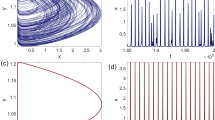Abstract
We consider a melt of cyclic polymers (N monomers per chain) containing a small volume fraction ϕ of open cycles (P monomers per chain, with P< N) with reactive ends. The reaction leads to the formation of small P-rings. If these P-rings trap a sufficient number ofN-rings, a macroscopic cluster (“Olympic” gel) will appear. Using a very primitive theory (where the statistics of knots is replaced by a statistics of proximity), we expect gelation to occur when ϕ > max P1/2/N,(1/N) exp(const/P). Our study is restricted to N-rings that are small enough for their conformations to be Gaussian.
Similar content being viewed by others
References
S. J. Clarson, J. E. Mark, and J. A. Semlyen,Polym. Comm. 27:244–245 (1986).
M. E. Cates and J. M. Deutsch,J. Physique 47:2121–2128 (1986).
A. R. Khokhlov and S. K. Nechaev,J. Phys. II France 6: 1547–1555 (1996);Phys. Lett. 112A:156–160 (1985).
Note that Eq. 4 might provide a crude approach for the modelization of experiments by Clarson, Mark and Semlyen on the trapping of cycles in networks (see Fig. 1 of ref. 1).
M. Gordon,Proc. Roy. Soc. A London 268:240 (1962); P. G. de Gennes,Scaling Concepts in Polymer Physics, Cornell University Press, NY, 4th. ed. (1985) Chapt. 5.
deP.G. Gennes,Macromol. 17:703–704 (1984).
For simplicity reasons, let us first assume that the N-chains are linear rather than cyclic. The Flory-Huggins free energy of the system,F, is then given byFa3/kT=gf/P)ℷ(ϕ/P) + [(1-ϕ)/N]log[(1-ϕ)/N]+Ξ(ϕ/P)(1-ϕ/P), where ϕ is the volume fraction of the P-chains. (8) The Flory parameter ξ characterises the interaction between reactive and nonreactive monomers, and the quantity ϕ/P in the interaction term is simply the concentration of reactive ends. From F, one can construct the Flory-Huggins free energyof mixing :(8) 118-01.The critical point (corresponding to the minimum value ofx on the spinodal curve)(8) is obtained when118-02 where118-03. The critical value ofx is given byXc-(P/2N)(N]/2 + P]/2)2 (note that this value of #, isP2 times larger than the usual value corresponding to the case where not only the ends but all the monomers of the F-chains are chemically different from the monomers of the iV-chains). ForN> P, the above formulae reduce to118-04 This last result indicates that, for any realistic value of the interaction parameter Ξ, the two types of chains are entirely compatible. In our problem, the N-chains are in fact cyclic (rather than linear) : according to the recent study of Khokhlov and Nechaev(3) (see also the work by Cates and Deutsch,(2) this should enhance the compatibility of the two types of chains even further.
P. G. de Gennes,Scaling Concepts in Polymer Physics, Cornell Univ. Press, Ithaca, 1979.
Author information
Authors and Affiliations
Rights and permissions
About this article
Cite this article
Raphaël, E., Gay, C. & de Gennes, P.G. Progressive construction of an “Olympic” gel. J Stat Phys 89, 111–118 (1997). https://doi.org/10.1007/BF02770756
Received:
Revised:
Issue Date:
DOI: https://doi.org/10.1007/BF02770756




